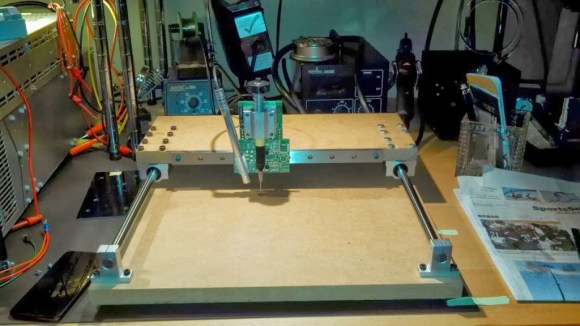 Populating a large surface mount PCB can take forever. [craftycoder] from Freeside Atlanta has built a great looking manual pick and place machine, removing the need for tweezers. No more will passives stick to your tweezers while you are trying to place them on your PCB!
Populating a large surface mount PCB can take forever. [craftycoder] from Freeside Atlanta has built a great looking manual pick and place machine, removing the need for tweezers. No more will passives stick to your tweezers while you are trying to place them on your PCB!
We have seen a lot of pick and place machines in the past few years. What makes this one stand out is its simplicity and the no-nonsense build. This pick and place is built on an MDF platform, uses bearings from Amazon, standard 12 mm rails, and has a small camera for a close-up look at your part placement. Sure it is a manual method, but it beats painstakingly placing each part with tweezers. It would be interesting to see how much this entire build cost; we expect that it was not too expensive. See this thing in action in the video after the break.
We hope this project has inspired you to go out and make something cool! If so, let us know what you have made!
https://www.youtube.com/watch?v=6ImOgzUy6QU
















Nice idea, however it needs a way to lock (or at least increase resistance for) the X and Y axis on demand, so that you don’t drag the part off the pads ;-)
Good idea, AKA the A. One way to implement this would be to use a stepper motor as a switchable dashpot. Just use a momentary pushbutton to short-circuit the windings.
Cool build! That looks very useful, despite the lack of CNC (which is always an option down the road). Just need to adjust that camera so the part is actually visible. In fact, it’d probably be a good idea to attach both the camera and the vacuum head to the Z axis, so they move together.
What a nice video and I like the construction. Well done.
I agree, cool build. I think the next step could be to make it semi-manual. Use encoders to keep track of the X-Y position, and map out areas where the different component tapes are. It sees that you picked up a resistor from a certain area, and then gives you direction LED’s to direct you to the right set of pads. This would give you an increase in speed by not requiring you to verify where each part goes, but without the accuracy needed of a true pick-N-place machine.
Nice idea!
+1, except his current system seems to need the board itself to move and rotate quite a bit, so solving that problem will have to come first (like allowing the vacuum tweezer to rotate, with optional 90 degree detents).
Didn’t read the article, so I may have missed some details. From what I saw in the video the tweezers did rotate, but he didn’t have the board secured, and just moved it as needed. So yeah, that would have to be considered.
Kinda reminded me of the differences between a GoTo telescope, a scope with digital setting circles, and a truly manual one.
place the camera vertically, place a flippable mirror in front…
i meant… horizontal… =|
I started getting the parts for this one a couple weeks ago:
http://vpapanik.blogspot.gr/2012/11/low-budget-manual-pick-place.html
I think Papanik’s is less expensive to build. I don’t think Freeside’s THK parts came cheap, though it’s possible they’re found materials.
I hope to try to make an offset so the camera & pen are vertical, and the offset is in the needle so the part is always at the center of vision.
I just realized that’s not going to work as it was in my head – no good way to turn the parts. Rats.
I picked up one of these bad boys a few weeks ago. Works great for populating small volumes of SMD boards. I just don’t have the dexterity to use tweezers without bumping everything else on the board and Steadyhands makes it super easy and fast to populate boards. WELL worth the money!
http://www.ebay.com/itm/SteadyHands-PNP-Manual-SMD-SMT-Pick-and-Place-with-Vacuum-/191120482395